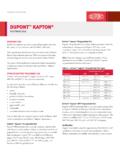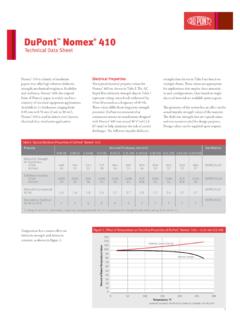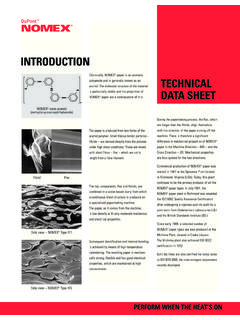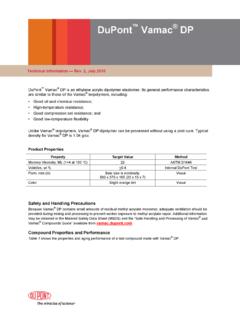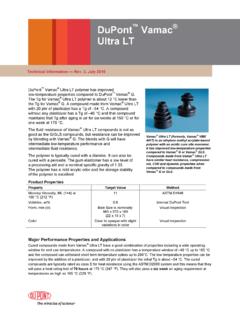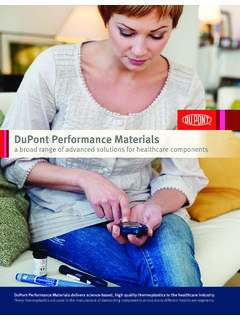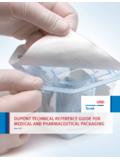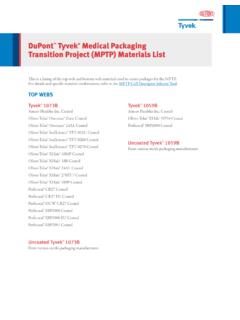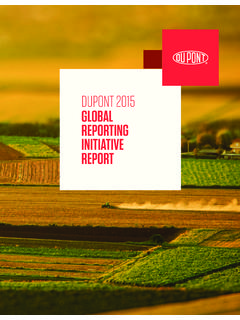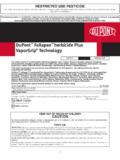Transcription of DuPont Tedlar Polyvinyl Fluoride (PVF) Films
1 Summary of PropertiesGeneral Unique properties of DuPont Tedlar Polyvinyl Fluoride (PVF) biaxially oriented film include excellent resistance to weathering, outstanding mechanical properties, and inertness towards a wide variety of chemicals, solvents, and staining agents. General properties are summarized in Table is available in clear or pigmented forms in Type 2, 3 and 5 and clear Type 4. These range from a high tensile strength, high flex variety (Type 2) to a high elongation, high tear modification (Type 4). A special Type 1 film is also available, which has controlled shrinkage. Tedlar contains no plasticizers; hence, it has good aging properties and remains tough and flexible over a broad temperature 5 Tedlar film has been developed for applications where deep draw and texturing are required. The proven characteristics of cleanability, durability, color stability, and color reproducibility are retained with this film type.
2 The film can also be printed on and laminated to a variety of 5 Tedlar applications exist where formed parts require surface protection, such as aircraft cabin interior surfaces containing complex curves. The high degree of formability of this film is obtained by extending both the elongation and ultimate tensile strength over a very broad range. Ultimate elongation is almost twice that of standard Type 3 film. Tedlar is supplied with different surface characteristics. A (one side adherable) and B (two side adherable) surfaces are used with adhesives for bonding to a wide variety of substrates. These surfaces have excellent compatibility with many classes of adhesives, including acrylics, polyesters, epoxies, rubbers and pressure-sensitive Tedlar Polyvinyl Fluoride (PVF) Films General PropertiesThe S surface has excellent anti-stick properties for use as a mold release agent for epoxies, phenolics, rubbers, and other plastic resins.
3 It is especially suited as a release sheet for printed circuit board and composite part weathering tests on Tedlar pigmented Films have been conducted for more than 20 years. The weather resistance, inertness and strength characteristics suggest broad use as a finish for metals, hardboards, felts, or plastics in architectural, decorative, or industrial uses. Properties of interest to the electrical industry include excellent hydrolytic stability and high dielectric strength and dielectric constant. Tedlar PVF film is generally available in thicknesses from to Tedlar Polyvinyl Fluoride (PVF) FilmsGeneral PropertiesPropertyTypical ValueTest MethodTest ConditionPHYSICALB ursting StrengthCoefficient of Friction (Film/Metal)DensityImpact StrengthMoisture AbsorptionWater Vapor TransmissionRefractive IndexTear Strength Propagated Initial (Graves)Tensile ModulusUltimate Tensile StrengthUltimate ElongationUltimate Yield29 65 g/cc10 20 in lb/mil< for most types9 57 nD15 60 g/mil260 500 g/mil300 380 x 103 psi8 16 x 103 psi90 250%6000 4900 psiMullen, ASTM D-774 ASTM D-1894 ASTM D-1505 Spencer ASTM D-3420 Water immersionASTM E-96 ASTM D-542 Abbe RefractometerElmendorf-ASTM D-1922 ASTM D-1004 ASTM D-882 ASTM D-882 ASTM D-882 ASTM D-88222 C (72 F)22 C (72 F)22 C (72 F)22 C (72 F)22 C (72 F)
4 C, 80% RH30 C (86 F)22 C (72 F)22 C (72 F)22 C (72 F)22 C (72 F)22 C (72 F)22 C (72 F)CHEMICALC hemical ResistanceGas Permeability Carbon Dioxide Helium Hydrogen Nitrogen OxygenVapor Permeability (at part. press. or vapor at given temp.) Acetic Acid Acetone Benzene Carbon Tetrachloride Ethyl Acetate Ethyl Alcohol HexaneWeatherability No visible effectStrength and appearance not cc/(100in2)(24 hr)(atm)(mil)150 cc/(100in2)(24 hr)(atm)(mil) cc/(100in2)(24 hr)(atm)(mil) cc/(100in2)(24 hr)(atm)(mil) cc/(100in2)(24 hr)(atm)(mil)45 g/(100m2)(hr)(mil) 10,000 g/(100m2)(hr)(mil)90 g/(100m2)(hr)(mil)50 g/(100m2)(hr)(mil)1000 g/(100m2)(hr)(mil)35 g/(100m2)(hr)(mil)55 g/(100m2)(hr)(mil)Excellent1 yr immersion inAcidsBasesSolvents2 hr immersion inAcidsBasesSolventsSoil Burial 5 yrASTM D-1434 ASTM D-1434 ASTM D-1434 ASTM D-1434 ASTM D-3985 ASTM E-96, modifiedASTM E-96, modifiedASTM E-96, modifiedASTM E-96, modifiedASTM E-96, modifiedASTM E-96, modifiedASTM E-96, modifiedFlorida exposure25 C (77 F)25 C (77 F)25 C (77 F)
5 BoilingBoilingBoiling 24 C (75 F)24 C (75 F)24 C (75 F)24 C (75 F)24 C (75 F)24 C (75 F)24 C (75 F)24 C (75 F)24 C (75 F)24 C (75 F)24 C (75 F)24 C (75 F)Facing South at 45 to horizontalTHERMALA gingHeat SealabilityLinear Coefficient of ExpansionShrinkage (Type 2) MD and TD (Type 3) TD only (Type 4) TD onlyTemperature Range Continuous Use Short Cycles or Release (1-2 hr)Zero Strength3000 hrSome varieties see Heat Sealability Techni-cal x 10-5 in/in/ F4% at 130 C (266 F)4% at 170 C (338 F) at 170 C (338 F)-72 to 107 C (-98 to 225 F)up to 175 C (350 F)260 to 300 C (500 to 570 F)Circulating Air OvenAir Oven, 30 minAir Oven, 30 minAir Oven, 30 minHot Bar150 C (302 F)ELECTRICALC orona Endurance (hr)Dielectric ConstantDielectric Strength (kV/mil)Dissipation Factor (%)Volume Resistivity ( )TTR20SG4 x 1013 7 x 1014 2 x 1010 x 1011 ASTM Suggested T methodASTM D-150 ASTM D-150 ASTM D-150 ASTM D-150 ASTM D-150 ASTM D-150 ASTM D-257 ASTM D-25760 cPs, 1000 V/mil)1 Kc at 22 C (72 F)60 cPs, kV/mil1000 cPs, 22 C (72 F)1000 cPs, 70 C (158 F)10 Kc, 22 C (72 F)10 Kc, 70 C (158 F)22 C (72 F)100 C (212 F)Table 1 General Properties of DuPont Tedlar PVF FilmsPhysical and Thermal PropertiesDuPont Tedlar PVF film is strong, flexible and fatigue-resistant.
6 Its resistance to failure by flexing is outstanding. Tedlar performs well in temperatures ranging from approximately -72 to 107 C (-98 to 225 F), with intermittent short-term peaking up to 204 C (400 F). Some physical and thermal properties of representative Tedlar PVF Films are summarized in Table 2 for the fabrication of specialty release Tedlar Polyvinyl Fluoride (PVF) FilmsGeneral milUV ScreeningTransparentType milTransparentType milLow GlossWhiteType milSatin WhiteType 3 DesignationUnitsTUT10BG3 TTR10BG3 TWH15BL3 TWH20BS3 Test MethodPhysical PropertiesArea Factorft2/lbm2 Ultimate TensileStrength, Min. (MD)kpsiMPa13901390855962 ASTM D-882 Tensile Modulus (MD)kpsiMPa3102,1383012,0753052,1033852, 655 ASTM D-882 Ultimate Elongation,Min. (MD)%959590110 ASTM D-882 Bursting Strengthpsi/ , ,845> >9,420 MullenASTM-D-774 Tear Strength Propagating (MD)g/ Strength Propagating (TD)g/ Strength Initial (MD)g/milkN/m373144423163333129506195 GravesASTM-D-1004 Tear Strength Initial (TD)g/milkN/m435168478185264102377146 GravesASTM-D-1004 Impact Strengthin lb/ D-3420 Specific Gravity D-1505 Coefficient ofFriction Film/Metal D-1894 Coefficient ofAbrasion 385 ASTM D-658 Moisture Absorption%< < < < D-570 Moisture E-96 Thermal PropertiesAging in AirHours toembrittlement3,0003,0003,0003,000 Oven at 300 FHeat Sealability Some varieties see Heat Sealability Technical BulletinLinear Coefficientof Expansion (MD) x x x x 10-5D-696(at 50 70 C)Linear Coefficientof Expansion (TD) x x x x 10-5D-696(at 50 70 C)Shrinkage, Max.
7 (TD)% at C6 at 1505 at 1705 at 1705 at 170 ASTM D-1204 Specific Heatcal/g CkJ/kg 990 Thermal AnalyzerTable 2 Typical Properties of DuPont Tedlar PVF FilmsCopyright 2014 DuPont . All rights reserved. The DuPont Oval Logo, DuPont , and all DuPont products denoted with or are registered trademarks or trademarks of E. I. du Pont de Nemours and Company or its affiliates. This information corresponds to our current knowledge on the subject. It is offered soley to provide possible suggestions for your own experimentations. It is not intended, however, to substitute for any testing you may need to conduct to determine for yourself the suitability of our products for your particular purposes. This information may be subject to revision as new knowledge and experi-ence becomes available. Since we cannot anticipate all variations in end-use conditions, DuPont makes no warranties, and assumes no liability in connection with any use of this information.
8 Noth-ing in this publication is to be considered as a license to operate under or a recommendation to infringe any patent right. CAUTION: Do not use in medical applications involving permanent implantation in the human body. For other medical applications, see DuPont Medical Caution Statement, H-50102-4. H-49725-5 Ltr 04/14 For more information on DuPont Tedlar PVF Films , please visit our Properties vs. Temperature DuPont Tedlar Polyvinyl Fluoride (PVF) FilmsGeneral PropertiesHydrolytic Stability DuPont Tedlar PVF film has excellent resistance to hydrolysis. Strength, yield stress, and elonga-tion are not measurably affected after 60 hr exposure in 85 psig steam 163 C (325 F).Thermal Aging
